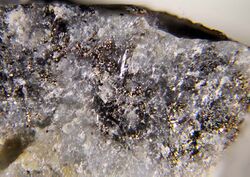Chemistry:Stannoidite
From HandWiki
| Stannoidite | |
|---|---|
 Silvery stannoidite crystals from the Akenobe Mine, Yabu City, Honshu Island, Japan, associated with chalcopyrite | |
| General | |
| Category | Sulfide mineral |
| Formula (repeating unit) | Cu6+Cu22+(Fe2+,Zn)3Sn2S12 |
| Strunz classification | 2.CB.15c |
| Crystal system | Orthorhombic |
| Crystal class | Disphenoidal (222) H-M symbol: (2 2 2) |
| Space group | I222 (No. 23) |
| Unit cell | a = 10.76 Å, b = 5.4 Å c = 16.09 Å, Z = 2 |
| Identification | |
| Color | Brass brown |
| Crystal habit | Uniformly indistinguishable crystals forming large masses |
| Cleavage | None |
| Fracture | Conchoidal – uneven |
| Mohs scale hardness | 4 |
| |re|er}} | Metallic |
| Streak | Brown gray |
| Diaphaneity | Opaque |
| Specific gravity | 4.29 |
| References | [1][2][3] |
Stannoidite is a sulfide mineral composed of five chemical elements: copper, iron, zinc, tin and sulfur. Its name originates from Latin stannum (tin) and Greek eides (or Latin oïda meaning "like"). The mineral is found in hydrothermal Cu-Sn deposits.[1][2]
Stannoidite was first described in 1969 for an occurrence in the Konjo mine, Okayama prefecture, Honshu Island, Japan .[2]
See also
References
- ↑ 1.0 1.1 Stannoidite. Webmineral
- ↑ 2.0 2.1 2.2 Stannoidite. Mindat.org
- ↑ Kudoh Y., Takeuchi Y. (1976). "The superstructure of stannoidite". Zeitschrift für Kristallographie – Crystalline Materials 144 (1–6): 145–160. doi:10.1524/zkri.1976.144.16.145. Bibcode: 1976ZK....144..145K.
- ↑ Warr, L.N. (2021). "IMA–CNMNC approved mineral symbols". Mineralogical Magazine 85 (3): 291–320. doi:10.1180/mgm.2021.43. Bibcode: 2021MinM...85..291W.
 |

